Hundreds of prehistoric cave paintings have been found around the globe and some are tens of thousands of years old. No one is quite sure when hominids developed the ability to abstract ideas and experiences into art though the earliest cave paintings show it was a long time ago. So what are the ten oldest cave paintings? With pictures, we’ll explain them now.
Discover the 10 Oldest Cave Paintings
These are ten of the oldest cave paintings on earth:
- Rock Lines at Blombos Cave
- Red Stencil of a Hand in Maltraviesco Cave
- Pig at the Leang Tedongnge Cave
- Hunting Scene at Maros-Pangkep Karst Caves
- Bovine at Lubang Jeriji Saleh Cave
- Red Disk at Cueva del Castillo
- Animals at Kapova Cave
- Figurative Paintings at Chauvet Cave
- Animals at Coliboaia Cave
- Rock Fragment at Nawarla Gabarnmang
10. Rock Fragment at Nawarla Gabarnmang: 28,000 Years Old
Nawarla Gabarnmang is an Australian cave art site in the Northern Territory. This cave hosts the most ancient cave drawings on the continent. A piece of rock from the decorated ceiling of an outcropping had artificial lines drawn on it that were carbon-dated to at least 28,000 years old though they may be much older.
Some of the other drawings at the site show crocodiles, wallabies, Asian sea bass, and people though not all date back tens of thousands of years. Within the last one hundred years, the cave has still been in use by locals, so many different kinds of drawings from many eras exist in one location.

Nawarla Gabarnmang Cave, Australia.
©Jean-Jacques Delannoy, CC BY-SA 4.0 <https://creativecommons.org/licenses/by-sa/4.0>, via Wikimedia Commons – License
9. Animals at Coliboaia Cave: 32,000 Years Old
Located in Apuseni Natural Park in Romania, the Coliboaia Cave hosts cave paintings that are at least 32,000 years old though this is debatable. Some scientists think it’s impossible to date these drawings because there is so much overlap between images from different periods in the same space.
Some of the animals depicted weren’t around in abundance yet in comparison to the supposed dates of the drawings. Nonetheless, the art in the Coliboaia Cave is some of the oldest in Eastern Europe. Some of the largest animals are a couple of feet in length, and the cave sports images of rhinoceroses, bison, and bears.
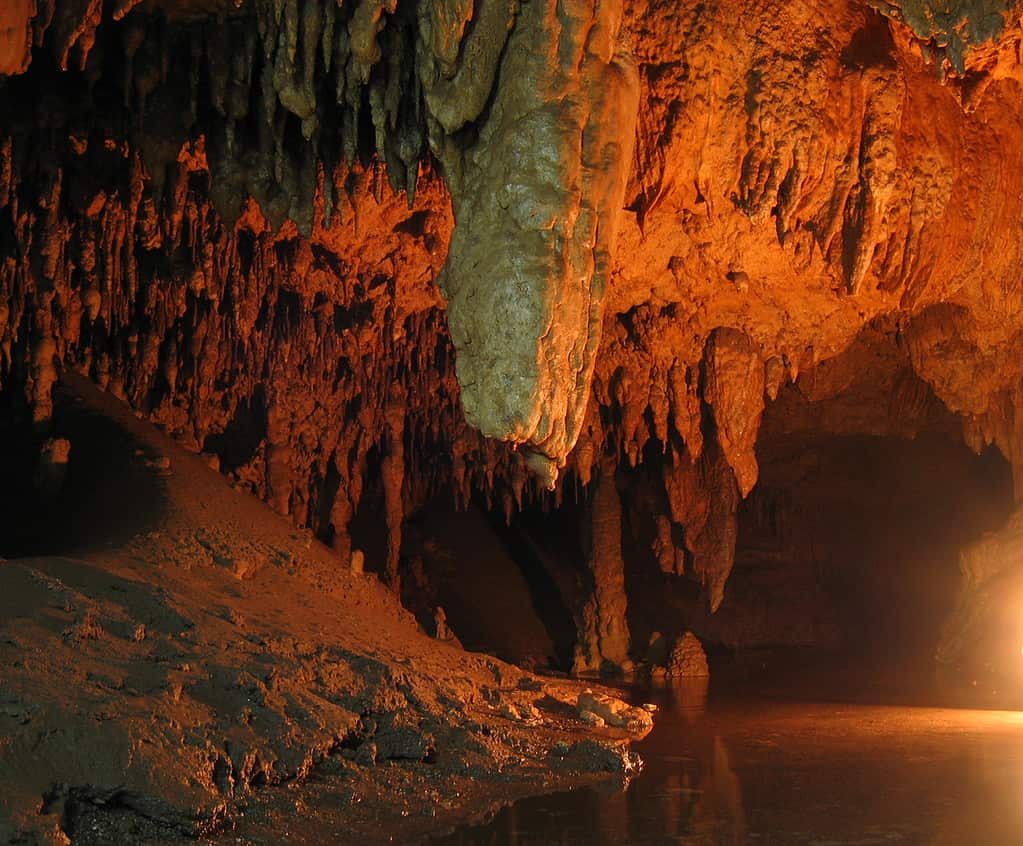
Coliboaia Cave, Romania.
©Tommy from Arad, CC BY 2.0 <https://creativecommons.org/licenses/by/2.0>, via Wikimedia Commons – License
8. Figurative Paintings at Chauvet Cave: 35,000 Years Old
The Chauvet Cave is located in France and contains some of the most well-preserved figurative cave art on the planet. While the exact dating of the earliest drawings isn’t certain, it’s generally accepted that the oldest depictions are around 35,000.
The scenes depicted show movement and interaction between around 13 species of animals alive at the time. While most other caves only show herbivores, the Chauvet drawings also depict predators like leopards, and the Ice Age spotted hyena. There are also abstract circles with dot patterns as well as handprints created by blowing pigment over a hand firmly placed against a rock.
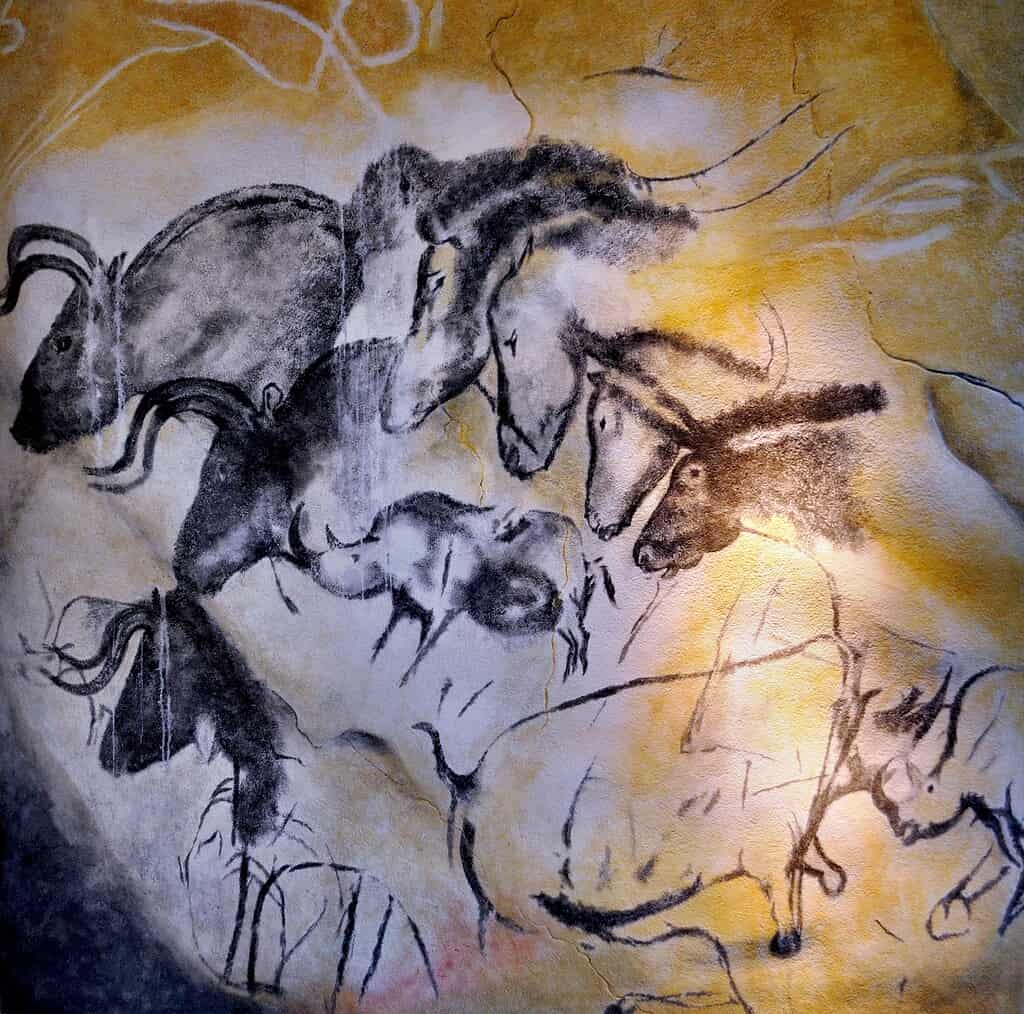
Chauvet Cave, France.
©Thomas T. from somewhere on Earth, CC BY-SA 2.0 <https://creativecommons.org/licenses/by-sa/2.0>, via Wikimedia Commons – License
7. Animals at Kapova Cave: 36,000 Years Old
Kapova Cave is in the Southern Urals of Russia and contains drawings around 36,000 years old. There are over 50 drawings spread out across four well-decorated chambers.
Some identifiable animals on the walls include rhinoceroses, buffalo, ibex, and mammoth. In addition, there may be drawings of humans or wild animals with human characteristics; however, this is inconclusive.
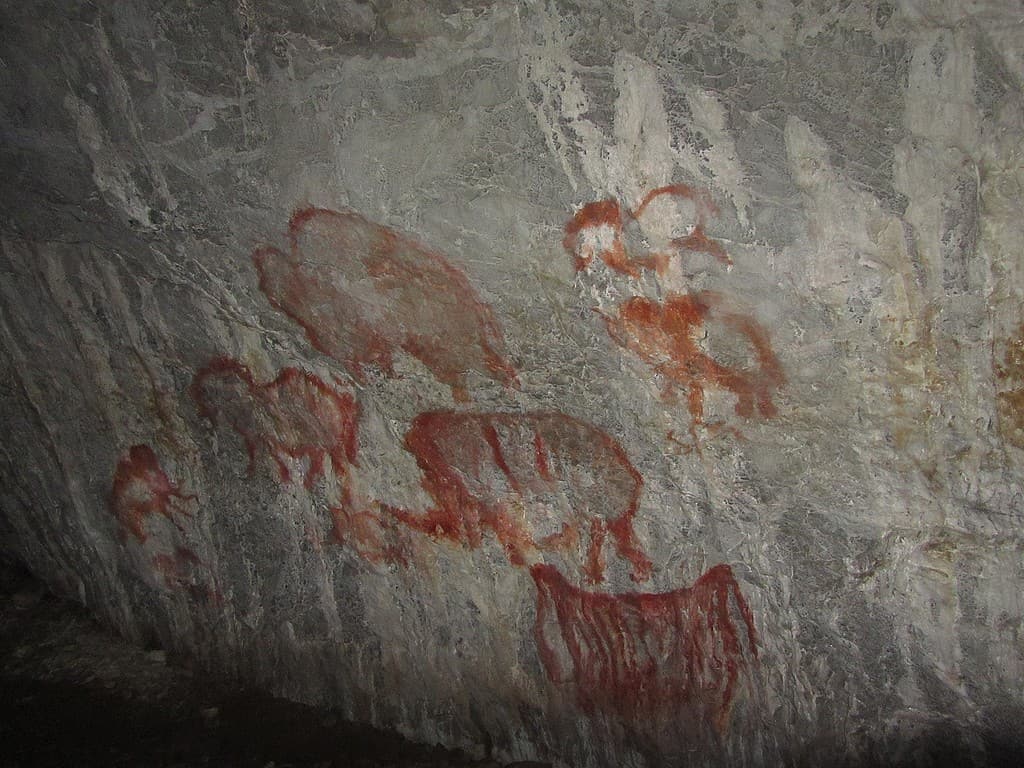
Kapova Cave, Russia.
©SaganZ, CC BY-SA 4.0 <https://creativecommons.org/licenses/by-sa/4.0>, via Wikimedia Commons – License
6. Red Disk at Cueva del Castillo: 40,000 Years Old
A cave near Cantabria in Spain has housed humans for around 150,000 years. While there are various artistic pieces within the Cueva del Castillo in Spain, the oldest discovered cave drawing is a red disk about 40,000 years old. Scientists could date it because it was covered by a calcite layer that easily gives up its age.
The Red Disk discovery is important because it demonstrates that humans created cave art in Europe before figurative representations emerged. Because earlier figurative representations exist on other continents, this may show that the ability to abstract ideas into art developed in Africa since the earliest humans disseminated from there. Art may have also emerged simultaneously in various places.
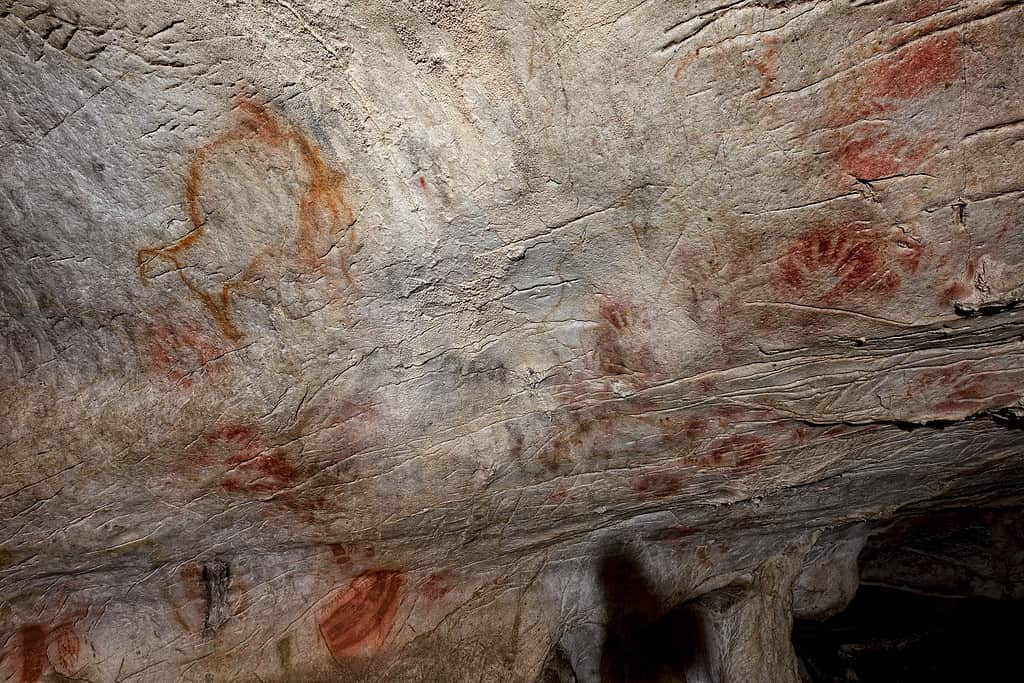
Cueva del Castillo, Spain.
©Gabinete de Prensa del Gobierno de Cantabria, CC BY 3.0 ES <https://creativecommons.org/licenses/by/3.0/es/deed.en>, via Wikimedia Commons – License
5. Bull at Lubang Jeriji Saleh Cave: 40,000 Years Old
Lubang Jeriji Saleh Cave is on the island of Borneo in Indonesia. When it was first discovered, it was the oldest figurative cave art on earth. While some outlines of fingers in the cave may be over 52,000 years old, the oldest figurative drawing is that of a banteng bull that’s 40,000 years old.
The discovery of this set of cave drawings was the first example of ancient cave art that demonstrated the possibility that representative art developed in multiple places. Moreover, it was the piece that provided the shift in academic thinking needed to change the narrative about the evolution of human consciousness.
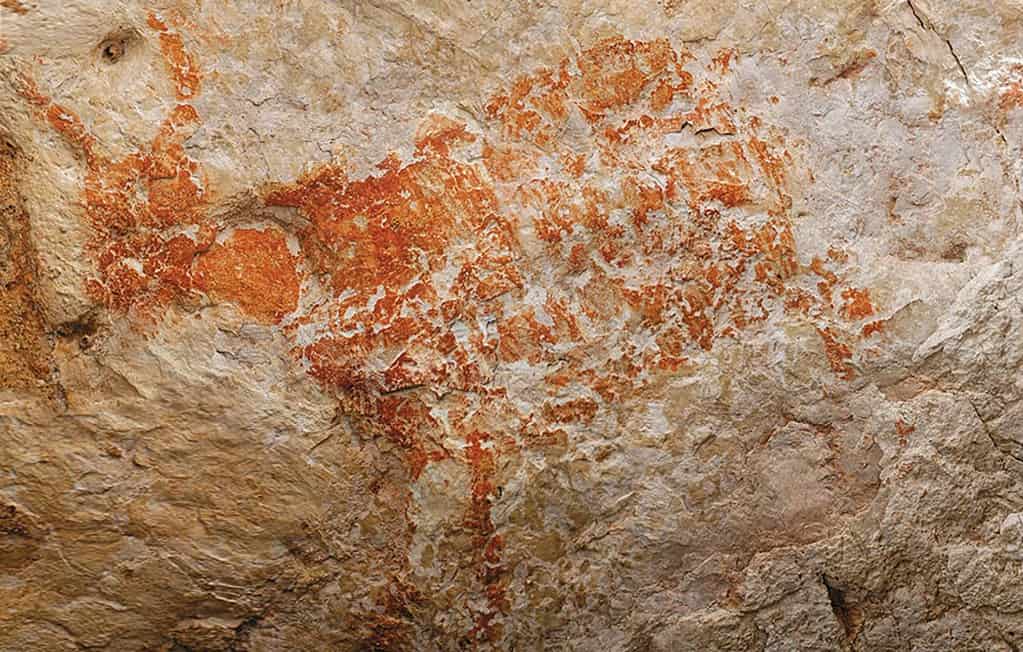
Lubang Jeriji Saleh Cave, Borneo, Indonesia.
©@ photo Luc-Henri Fage, www.fage.fr., Public domain, via Wikimedia Commons – License
4. Hunting Scene at Leang Bulu Sipong 4: 43,900 Years Old
One of the oldest cave paintings on earth is a hunting scene depicting humans and pigs. Within that scene is a specific warty pig that is around 43,900 years old.
This scene is found in the Maros-Pangkep karst caves in South Sulawesi, Borneo, Indonesia. The name of the specific cave is Leang Bulu Sipong. This cave complex boasts an older drawing in a separate cave, and both of these drawings are demonstrations of some of the earliest figurative art found on earth.

Maros-Pangkep karst caves in South Sulawesi, Indonesia
©Stephans history, CC BY-SA 4.0 <https://creativecommons.org/licenses/by-sa/4.0>, via Wikimedia Commons – License
3. Pig at the Leang Tedongnge Cave: 45,500 Years Old
The warty pig in the Leang Tedongnge Cave in the Maros-Pangkep karst in Indonesia is the oldest example of figurative art on earth. Within this cave complex are other examples of some of the oldest representative art on the planet, including the previous hunting scene described above.
While the cave art in this complex is some of the most ancient, there is substantial evidence of hominid occupation in this karst for almost 200,000 years. However, this drawing is the earliest evidence of Homo sapiens settlement in the wider geographical region.
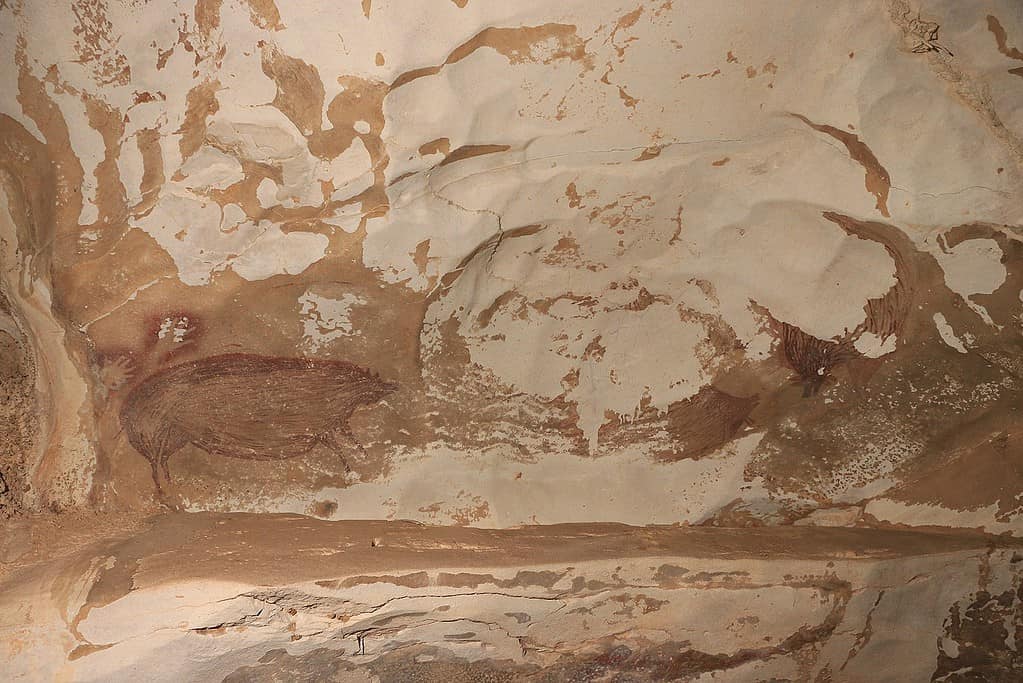
Leang Tedongnge Cave in the Maros-Pangkep karst in Indonesia.
©Basran Burhan, CC BY-SA 4.0 <https://creativecommons.org/licenses/by-sa/4.0>, via Wikimedia Commons – License
2. Red Stencil of a Hand in Maltravieso Cave: 64,000 Years Old
The oldest cave painting is a hand stencil made by a Neanderthal over 64,000 years ago in the Maltravieso Cave in Cáceres, Spain. Scientists know a Neanderthal made this handprint because Homo sapiens hadn’t arrived in the region yet. Modern humans wouldn’t live in Spain for another 20,000 years.
This challenges the common misconception that Neanderthals were animalistic and uncomplicated in comparison to Homo sapiens. Before, it was assumed that all Neanderthal culture was inherited by migrating Homo sapiens, as no artistic object predated the arrival of modern people.
It also shows that Neanderthals were capable of disseminating information between generations. This allowed for complex techniques such as pigment mixing and the calculated application of color.
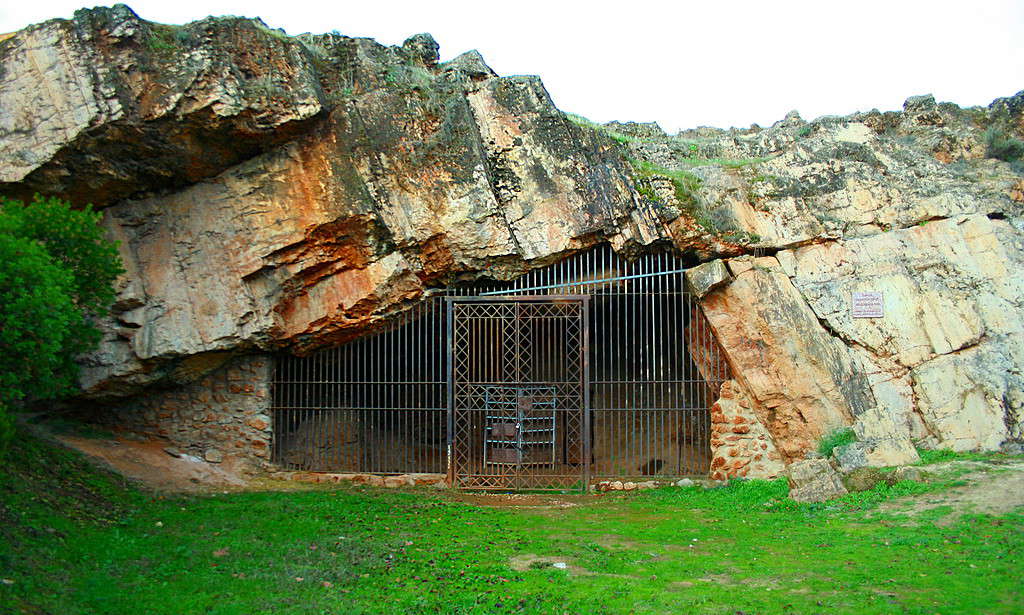
Entrance to Maltravieso Cave, Spain.
©Mario modesto, CC BY-SA 3.0 <https://creativecommons.org/licenses/by-sa/3.0>, via Wikimedia Commons – License
1. Rock Lines at Blombos Cave: 73,000 Years Old
A rock was found in South Africa at a place called the Blombos Cave. This rock has numerous crossing lines drawn on it; some required the wielding of a manufactured and precise ochre utensil. It’s been determined that the ochre marks are 73,000 years old.
This discovery is important because it shows that early modern humans in South Africa were already capable of creative design before mass migration from the African continent occurred. In the past, most academics believed that Europe was the center of human development.

Blombos Cave Rock, South Africa.
©Chris S. Henshilwood, CC BY-SA 4.0 <https://creativecommons.org/licenses/by-sa/4.0>, via Wikimedia Commons – License
The photo featured at the top of this post is © Claude Valette, CC BY-SA 4.0
Thank you for reading! Have some feedback for us? Contact the AZ Animals editorial team.






